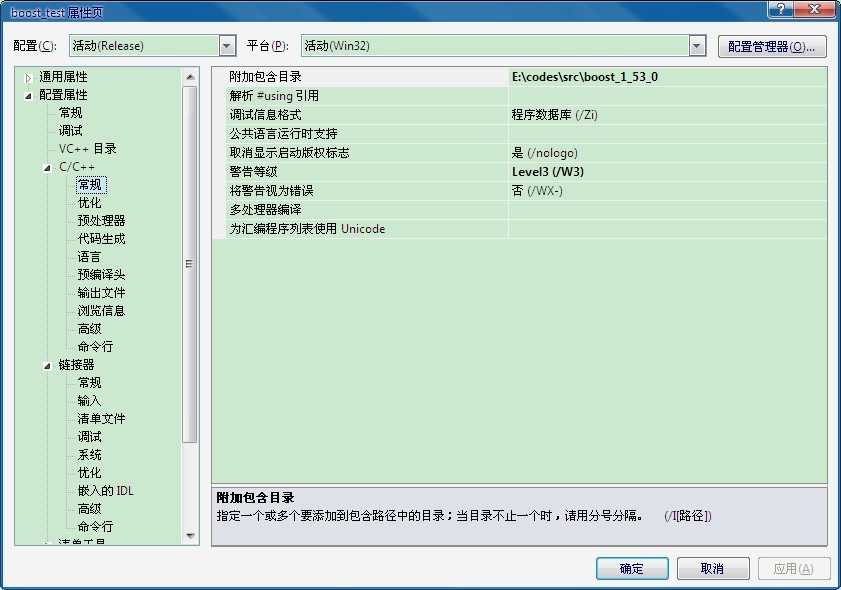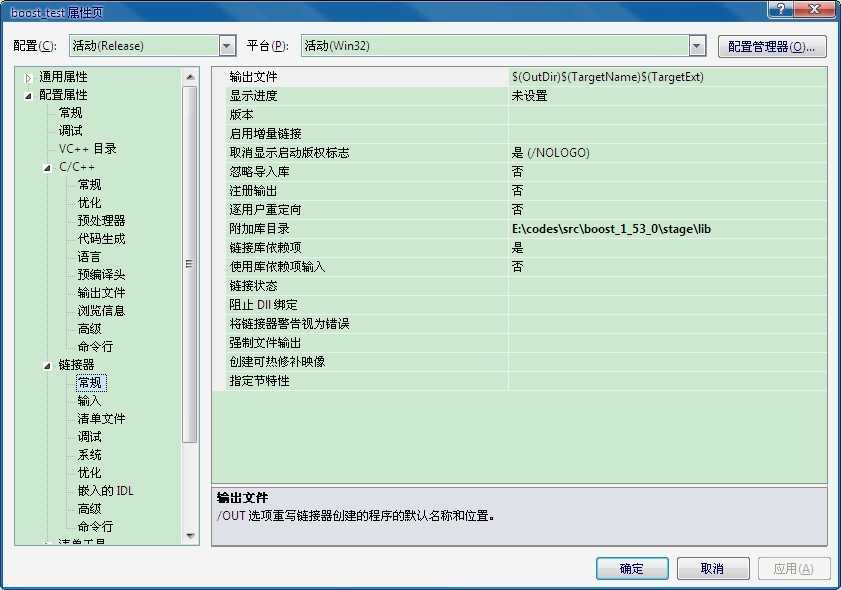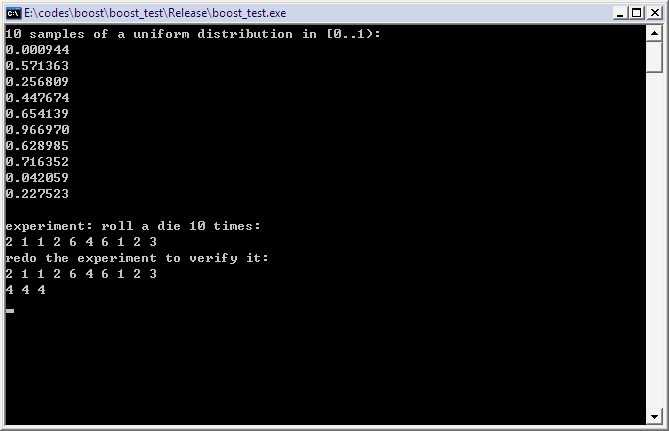标签:factor sequence ace 划线 csu title when ror art
1、下载最新版本的boost库.所在地址:boost_1_53_0.zip.官方推荐7z压缩格式的,因为其压缩效率更好,相应包的大小也比较小。
2、解压缩到指定目录,如C:\boost_1_53.下面开始遵照官方页面的步骤进行编译。()
3、下面要选择一个编译平台。所谓的编译平台,指的具体的编译环境,官方给出了一个列表。

这里,我们的编译环境使用的是VS2010,也就是VC10,所以我们将toolset指定为msvc.在VS2010的工具选项中打开visual studio命令提示(2010) 。这个命令提示框中已经配置了VS2010的编译环境变量,不用再手动配置什么环境变量。
4、接下来还有一个准备工作要做,为编译期间产生的中间文件指定一个目录,我指定为c:\boost_1_53\build_manual。
5、开始编译。退回到boost源码的根目录,运行命令:
b2 --build-dir=build-directory toolset=toolset-name --build-type=complete stage
我的编译命令为: b2 --build-dir=c:\boost_1_53\build_manual toolset=msvc --build-type=complete stage
6、全部编译时间耗费了半个小时(机器性能较好的缘故)。一般要耗费将近一小时。编译过程会产生很多警告,这些都不要紧。只要不产生errors而终止编译过程,那么都是没有关系的。
编译产生的文件会有四五个GB大小。所以,最好保证源代码所在文件有足够的磁盘空间。
7、编译完成后,只有stage\lib\下面这些个文件lib文件,才是我们最终需要的。其他编译产生的文件都无关痛痒。
8、配置VS2010开发boost程序的环境。


9、注意自己配置的地方:附加包含目录,附加库目录。要注意的是,附加包含目录中,一定不要写成这种形式:E:\codes\src\boost_1_53_0\boost!!这样,在包含头文件的时候,编译器会报错找不到头文件。因为写成这样,会把\boost这个路径给去掉了。而头文件内部依赖的很多其他头文件又是相对于\boost这个路径的。编译无疑无法通过。
10、编译boost库自带的一个源程序:
1 #include <iostream>
2 #include <fstream>
3 #include <ctime> // std::time
4
5 #include <boost/random/linear_congruential.hpp>
6 #include <boost/random/uniform_int.hpp>
7 #include <boost/random/uniform_real.hpp>
8 #include <boost/random/variate_generator.hpp>
9 #include <boost/generator_iterator.hpp>
10
11 // This is a typedef for a random number generator.
12 // Try boost::mt19937 or boost::ecuyer1988 instead of boost::minstd_rand
13 typedef boost::minstd_rand base_generator_type;
14
15 // This is a reproducible simulation experiment. See main().
16 void experiment(base_generator_type & generator)
17 {
18 // Define a uniform random number distribution of integer values between
19 // 1 and 6 inclusive.
20 typedef boost::uniform_int<> distribution_type;
21 typedef boost::variate_generator<base_generator_type&, distribution_type> gen_type;
22 gen_type die_gen(generator, distribution_type(1, 6));
23
24 // If you want to use an STL iterator interface, use iterator_adaptors.hpp.
25 boost::generator_iterator<gen_type> die(&die_gen);
26 for(int i = 0; i < 10; i++)
27 std::cout << *die++ << " ";
28 std::cout << ‘\n‘;
29 }
30
31 int main()
32 {
33 // Define a random number generator and initialize it with a reproducible
34 // seed.
35 base_generator_type generator(42);
36
37 std::cout << "10 samples of a uniform distribution in [0..1):\n";
38
39 // Define a uniform random number distribution which produces "double"
40 // values between 0 and 1 (0 inclusive, 1 exclusive).
41 boost::uniform_real<> uni_dist(0,1);
42 boost::variate_generator<base_generator_type&, boost::uniform_real<> > uni(generator, uni_dist);
43
44 std::cout.setf(std::ios::fixed);
45 // You can now retrieve random numbers from that distribution by means
46 // of a STL Generator interface, i.e. calling the generator as a zero-
47 // argument function.
48 for(int i = 0; i < 10; i++)
49 std::cout << uni() << ‘\n‘;
50
51 /*
52 * Change seed to something else.
53 *
54 * Caveat: std::time(0) is not a very good truly-random seed. When
55 * called in rapid succession, it could return the same values, and
56 * thus the same random number sequences could ensue. If not the same
57 * values are returned, the values differ only slightly in the
58 * lowest bits. A linear congruential generator with a small factor
59 * wrapped in a uniform_smallint (see experiment) will produce the same
60 * values for the first few iterations. This is because uniform_smallint
61 * takes only the highest bits of the generator, and the generator itself
62 * needs a few iterations to spread the initial entropy from the lowest bits
63 * to the whole state.
64 */
65 generator.seed(static_cast<unsigned int>(std::time(0)));
66
67 std::cout << "\nexperiment: roll a die 10 times:\n";
68
69 // You can save a generator‘s state by copy construction.
70 base_generator_type saved_generator = generator;
71
72 // When calling other functions which take a generator or distribution
73 // as a parameter, make sure to always call by reference (or pointer).
74 // Calling by value invokes the copy constructor, which means that the
75 // sequence of random numbers at the caller is disconnected from the
76 // sequence at the callee.
77 experiment(generator);
78
79 std::cout << "redo the experiment to verify it:\n";
80 experiment(saved_generator);
81
82 // After that, both generators are equivalent
83 assert(generator == saved_generator);
84
85 // as a degenerate case, you can set min = max for uniform_int
86 boost::uniform_int<> degen_dist(4,4);
87 boost::variate_generator<base_generator_type&, boost::uniform_int<> > deg(generator, degen_dist);
88 std::cout << deg() << " " << deg() << " " << deg() << std::endl;
89
90 {
91 // You can save the generator state for future use. You can read the
92 // state back in at any later time using operator>>.
93 std::ofstream file("rng.saved", std::ofstream::trunc);
94 file << generator;
95 }
96
97 getchar();
98 return 0;
99 }
这是一个生成随机数的程序,其运行结果如下:

http://www.cnblogs.com/csuftzzk/archive/2013/04/30/3052046.html
标签:factor sequence ace 划线 csu title when ror art
原文地址:http://www.cnblogs.com/findumars/p/6025092.html